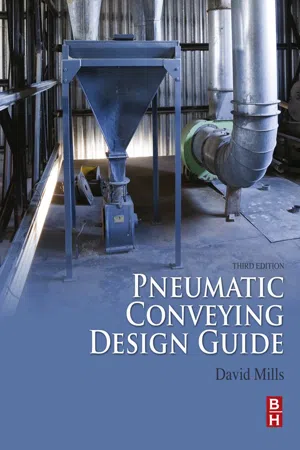
- 806 pages
- English
- ePUB (mobile friendly)
- Available on iOS & Android
Pneumatic Conveying Design Guide
About this book
Pneumatic Conveying Design Guide, 3rd Edition is divided into three essential parts, system and components, system design, and system operation, providing both essential foundational knowledge and practical information to help users understand, design, and build suitable systems.All aspects of the pneumatic conveying system are covered, including the type of materials used, conveying distance, system constraints, including feeding and discharging, health and safety requirements, and the need for continuous or batch conveying.This new edition also covers information on the other conveying systems available and compares them to this method. The existing content is brought up-to-date and the references are expanded and updated. This guide is an almost encyclopedic coverage of pneumatic conveying and as such is an essential text for both designers and users of pneumatic conveying systems. Each aspect of the subject is discussed from basic principles to support those new to, or learning about, this versatile technique.- Highly practical with usable and unbiased information to enable you to choose, design and build suitable systems with a high degree of confidence- New edition compares alternative conveying systems including pneumatic capsule conveying systems, and covers conveying of wet materials- Contains updated information on by-pass systems, and will introduce you to simulation software
Frequently asked questions
- Essential is ideal for learners and professionals who enjoy exploring a wide range of subjects. Access the Essential Library with 800,000+ trusted titles and best-sellers across business, personal growth, and the humanities. Includes unlimited reading time and Standard Read Aloud voice.
- Complete: Perfect for advanced learners and researchers needing full, unrestricted access. Unlock 1.4M+ books across hundreds of subjects, including academic and specialized titles. The Complete Plan also includes advanced features like Premium Read Aloud and Research Assistant.
Please note we cannot support devices running on iOS 13 and Android 7 or earlier. Learn more about using the app.
Information
The Determination of Relevant Material Properties
Abstract
Keywords
Deaeration constant; Elutriation; Laser diffraction; Particle shape; Permeameter; Pycnometer; Sedimentation; Shape factor; Specific surface; VoidageIntroduction
The Need for Characterization
Table of contents
- Cover image
- Title page
- Table of Contents
- Copyright
- Preface to the Third Edition
- Part A. Conveying in Pipelines
- Part B. Conveying System Components
- Part C. Gas and Solid Flows
- Part D. Conveying System Design
- Part E. Conveying System Operation
- Appendix 1. The Determination of Relevant Material Properties
- Appendix 2. Additional Conveying Data
- Index